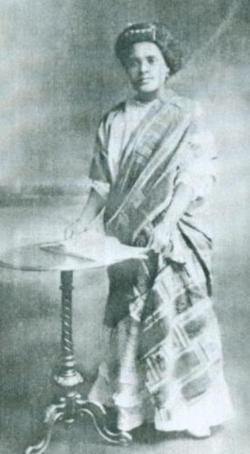Adelaide Casely-Hayford (1868-1960)
Published: 7 March 2021
Educator, Pan-Africanist, social justice activist, writer, teacher

Educator, Pan-African, social justice activist, writer, teacher
In honour of International Women’s Day and the IWD 2021 theme, #ChoosetoChallenge, we spotlight Adelaide Casely-Hayford (1868-1960)
Casely-Hayford was the child of a Fanti royal, grandchild of Liberated Africans and great-grandchild of Jamaican Maroons. She was born in 1868 in Freetown, Sierra Leone, a colony established as part of the struggle to end the transatlantic slave trade and where tens of thousands of enslaved Africans were liberated from slave ships. As a teenager, she studied music in Germany. After that she lived for some time in England, then worked as a teacher in Sierra Leone in 1892, before moving back to England to run a boarding house. She married, then divorced, Gold Coast author and lawyer, Ekra-Agiman, also known as Joseph Ephraim Casely Hayford.
As a newly-single woman and mother, she returned to Sierra Leone and became a leading Pan-Africanist and feminist thinker.
In Sierra Leone, she joined and then became “lady president” of the Freetown branch of Marcus Garvey’s Universal Negro Improvement Association (UNIA). In this position, she articulated an African feminism, which harnessed cultural nationalism with a forceful assertion of the rights of African woman. The text of her most famous speech, ‘The Rights of Women and Christian Marriage’ delivered in Freetown in 1915 has not survived, but in a 1922 editorial she expressed her hope that “Africa shall be allowed a chance to expand and develop along her own ideas and ideals”. (A. Hayford, “West Africa in America,” West Africa, 5 (1922): 1656). Her speaking tour of the United States sought to correct American misapprehensions about African society. She adopted West African dress, put on dramatic interpretations and promoted the preservation of African craft traditions.
Inspired by a visit to Mrs Booker T. Washington’s school for women, and the Tuskagee Institute, she established the Freetown Girls’ Vocational School in 1923. Unlike the British colonial schools the curriculum included African history and sought to inculcate;
“a love of country, a pride of race, an enthusiasm for the black man’s capabilities, and a genuine admiration for Africa’s wonderful art work.” A. Hayford, “A Girl’s School in West Africa,” Southern Workman (October 1926), 450.
She remained politically active and attended the Fourth Pan-African Congress in New York City in 1927. Through this, she remained principal of the girls’ school, and described herself as a “race woman through and through.” (Keisha Blain, ‘Emerging Feminisms, A Historical Note: Pan-African Feminist Adelaide Casely Hayford’, the feminist wire, 28 March, 2016). Her commitment to Pan-Africanism and feminism took material form in the improved educational opportunities for Sierra Leonean girls, as well as a wealth of literary and political writing.
Further reading
- Keisha Blain, ‘Emerging Feminisms, A Historical Note: Pan-African Feminist Adelaide Casely Hayford’, The Feminist Wire, 28 March 2016.
- Adelaide M. Cromwell, An African Victorian Feminist; the Life and Times of Adelaide Smith Casely Hayford, 1868–1960. Howard University Press, 1992.
- Rina Okonkwo, ‘Adelaide Casely Hayford Cultural Nationalist and Feminist’, Phylon. (January 1981), 42:1.
First published: 7 March 2021

